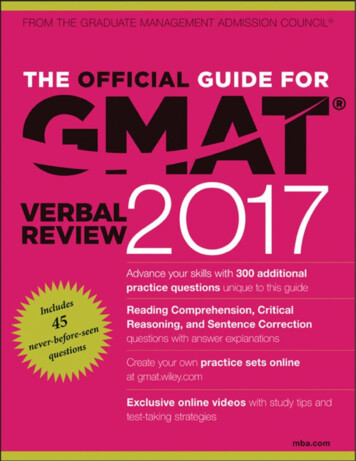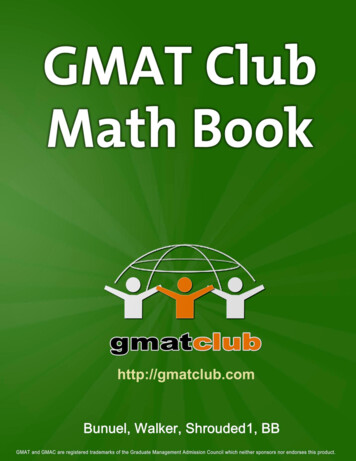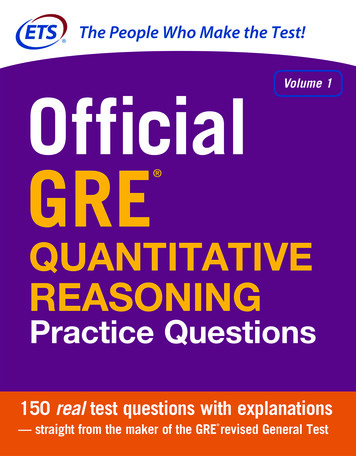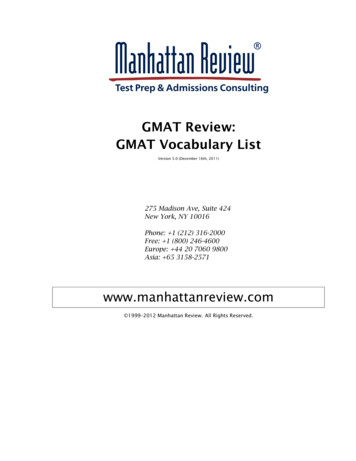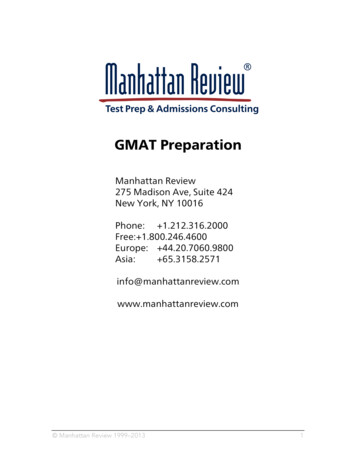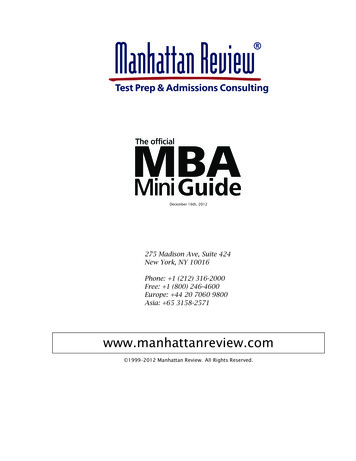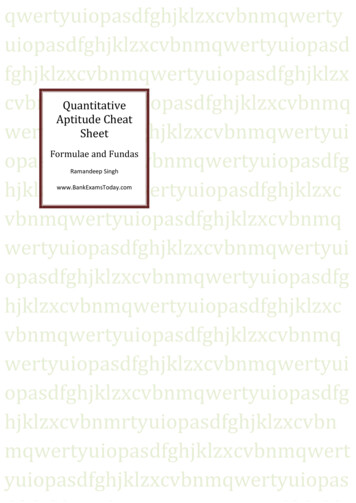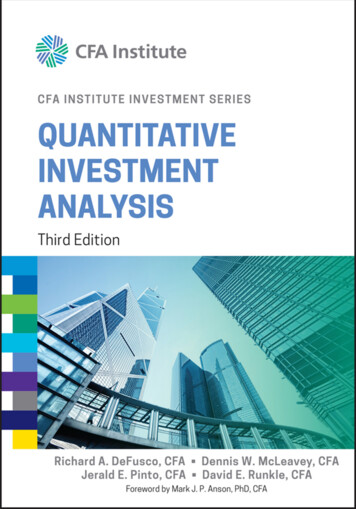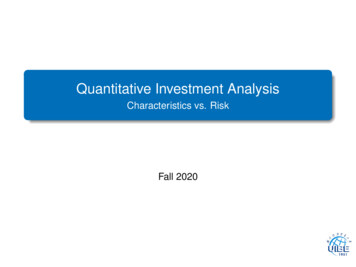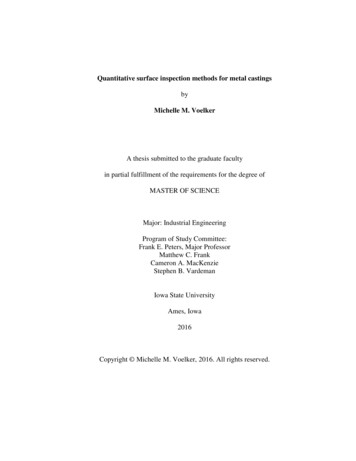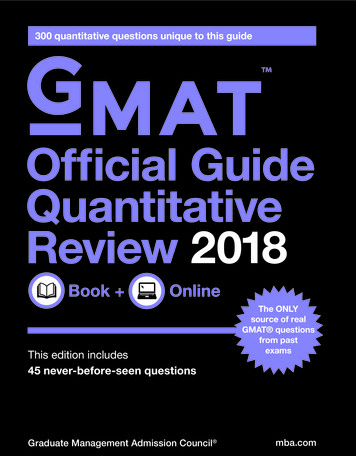
Transcription
300 quantitative questions unique to this guideOfficial GuideQuantitativeReview 2018Book OnlineThis edition includes45 never-before-seen questionsGraduate Management Admission Council The ONLYsource of realGMAT questionsfrom pastexamsmba.com
GMAT OFFICIAL GUIDE 2018 QUANTITATIVE REVIEWCopyright 2017 by the Graduate Management Admission Council . All rights reserved.Published by John Wiley & Sons, Inc., Hoboken, New Jersey.No part of this publication may be reproduced, stored in a retrieval system or transmitted in any form orby any means, electronic, mechanical, photocopying, recording, scanning or otherwise, except as permittedunder Sections 107 or 108 of the 1976 United States Copyright Act, without either the prior writtenpermission of the Publisher, or authorization through payment of the appropriate per-copy fee to theCopyright Clearance Center, 222 Rosewood Drive, Danvers, MA 01923, (978) 750-8400, fax (978) 646-8600,or on the Web at www.copyright.com. Requests to the Publisher for permission should be addressed to thePermissions Department, John Wiley & Sons, Inc., 111 River Street, Hoboken, NJ 07030, (201) 748-6011,fax (201) 748-6008, or online at http://www.wiley.com/go/permissions.The publisher and the author make no representations or warranties with respect to the accuracy orcompleteness of the contents of this work and specifically disclaim all warranties, including withoutlimitation warranties of fitness for a particular purpose. No warranty may be created or extended by sales orpromotional materials. The advice and strategies contained herein may not be suitable for every situation.This work is sold with the understanding that the publisher is not engaged in rendering legal, accounting,or other professional services. If professional assistance is required, the services of a competent professionalperson should be sought. Neither the publisher nor the author shall be liable for damages arising herefrom. The fact that an organization or Web site is referred to in this work as a citation and/or a potentialsource of further information does not mean that the author or the publisher endorses the information theorganization or Web site may provide or recommendations it may make. Further, readers should be awarethat Internet Web sites listed in this work may have changed or disappeared between when this work waswritten and when it is read.Trademarks: Wiley, the Wiley Publishing logo, and related trademarks are trademarks or registeredtrademarks of John Wiley & Sons, Inc. and/or its affiliates. The GMAC and GMAT logos, GMAC ,GMASS , GMAT , GMAT CAT , Graduate Management Admission Council , and GraduateManagement Admission Test are registered trademarks of the Graduate Management AdmissionCouncil (GMAC ) in the United States and other countries. All other trademarks are the property oftheir respective owners. Wiley Publishing, Inc. is not associated with any product or vendor mentioned inthis book.For general information on our other products and services or to obtain technical support please contact ourCustomer Care Department within the U.S. at (877) 762-2974, outside the U.S. at (317) 572-3993 orfax (317) 572-4002.Wiley also publishes its books in a variety of electronic formats. Some content that appears in print may notbe available in electronic books. For more information about Wiley products, please visit our Web site atwww.wiley.com.ISBN 978-1-119-38749-7 (pbk); ISBN 978-1-119-40238-1 (ePDF); ISBN 978-1-119-40237-4 (ePub)Printed in the United States of America10987654321
Letter from the President and CEO, GMAC v1.01.01.11.21.31.41.51.61.71.81.91.101.11What is the GMAT Exam?What is the GMAT Exam?Why Take the GMAT Exam?GMAT Exam FormatWhat Is the Content of the Exam Like?Integrated Reasoning SectionQuantitative SectionVerbal SectionAnalytical Writing AssessmentWhat Computer Skills Will I Need?What Are the Test Centers Like?How Are Scores Calculated?Test Development Process23345667777892.02.02.12.22.32.4How to PrepareHow to PrepareHow Can I Best Prepare to Take the Test?What About Practice Tests?Where Can I Get Additional Practice?General Test-Taking Suggestions1011111112123.03.03.13.23.33.4Math ReviewMath ReviewArithmeticAlgebraGeometryWord Problems1415162735474.04.04.14.24.34.44.5Problem SolvingProblem SolvingTest-Taking StrategiesThe DirectionsSample QuestionsAnswer KeyAnswer a SufficiencyData SufficiencyTest-Taking StrategiesThe DirectionsSample QuestionsAnswer KeyAnswer Explanations148149150152154166167Answer SheetsProblem Solving Answer SheetData Sufficiency Answer Sheet214215216Table of ContentsAppendix A
Dear GMAT Test-Taker,Thank you for your interest in graduate management education. Taking the GMAT exam lets schoolsknow that you’re serious about your graduate business education. By using the Official Guide to preparefor the GMAT, you’re taking a very important step toward achieving your goals and pursuing admissionto a high-quality business school or master’s program.This book, GMAT Official Guide 2018 Quantitative Review, is designed to help you prepare for andbuild confidence to do your best on the GMAT exam. It’s the only guide of its kind on the market thatincludes real GMAT exam questions published by the Graduate Management Admission Council(GMAC), the makers of the exam.GMAC was founded by the world’s leading business schools in 1953. The GMAT exam was developedto help people who aspire to careers in management demonstrate their command of the skills neededfor success in the classroom. Schools use and trust the GMAT exam as part of their admissions processbecause it’s an excellent predictor of classroom success and your ability to excel in your chosen program.Today more than 6,500 graduate programs around the world use the GMAT exam to establish theirMBA, graduate-level management degrees and specialized programs as hallmarks of excellence. Nine outof 10 new MBA enrollments at Top 50 US full-time MBA programs are made using a GMATscore.These facts make us proud and drive us to keep improving the GMAT as well as play a role in helpingyou find and gain admission to the best school or program for you. We’re committed to ensuringthat no talent goes undiscovered, and that more people around the world can pursue opportunities ingraduate management education.I applaud your commitment to educational success, and I know that this book and the other OfficialGMAT preparation materials available at mba.com will give you the confidence to achieve yourpersonal best on the GMAT exam and launch or reinvigorate a rewarding career.I wish you the best success on all your educational and professional endeavors in the future.Sincerely,Sangeet ChowflaCEO of the Graduate Management Admission Council
GMAT Official Guide 2018Quantitative Review
1.0 What Is the GMAT Exam?2
1.0 What Is the GMAT Exam?1.0 What Is the GMAT Exam?The Graduate Management Admission Test (GMAT ) exam is a standardized exam used inadmissions decisions by more than 6,500 graduate management programs worldwide. It helps yougauge, and demonstrate to schools, your academic potential for success in graduate-level managementstudies.The four‐part exam measures your Analytical Writing, Verbal, Quantitative, and Integrated Reasoningskills—higher‐order reasoning skills that management faculty worldwide have identified as importantfor incoming students to have. “Higher-order” reasoning skills involve complex judgments, and includecritical thinking, analysis, and problem solving. Unlike undergraduate grades and curricula, which vary intheir meaning across regions and institutions, your GMAT scores provide a standardized, statistically validand reliable measure of how you are likely to perform academically in the core curriculum of a graduatemanagement program. The GMAT exam’s validity, fairness, and value in admissions have been well‐established through numerous academic studies.The GMAT exam is delivered entirely in English and solely on a computer. It is not a test of businessknowledge, subject matter mastery, English vocabulary, or advanced computational skills. The GMATexam also does not measure other factors related to success in graduate management study, such as jobexperience, leadership ability, motivation, and interpersonal skills. Your GMAT score is intended to beused as one admissions criterion among other, more subjective, criteria, such as admissions essays andinterviews.1.1 Why Take the GMAT Exam?Launched in 1954 by a group of nine business schools toprovide a uniform measure of the academic skills neededto succeed in their programs, the GMAT exam is nowused by more than 6,500 graduate management programsat approximately 2,100 institutions worldwide.Taking the GMAT exam helps you stand out in theadmissions process and demonstrate your readiness andcommitment to pursuing graduate management education.Schools use GMAT scores to help them select the mostqualified applicants—because they know that candidateswho take the GMAT exam are serious about earning agraduate business degree, and it’s a proven predictor of astudent’s ability to succeed in his or her chosen program.When you consider which programs to apply to, youcan look at a school’s use of the GMAT exam as oneindicator of quality. Schools that use the GMAT examtypically list score ranges or average scores in their classprofiles, so you may also find these profiles helpful ingauging the academic competitiveness of a program youare considering and how well your performance on theexam compares with that of the students enrolled in theprogram.Myth -vs- FACTM – If I don’t achieve a high scoreon the GMAT, I won’t get intomy top choice schools.F – There are great schoolsavailable for candidates at anyGMAT score range.Fewer than 50 of the more than 250,000people taking the GMAT exam each year geta perfect score of 800; and many more getinto top business school programs aroundthe world each year. Admissions Officersuse GMAT scores as one component in theiradmissions decisions, in conjunction withundergraduate records, application essays,interviews, letters of recommendation, andother information when deciding whomto accept into their programs. Visit SchoolFinder on mba.com to learn about schoolsthat are the best fit for you.3
GMAT Official Guide 2018 Quantitative ReviewNo matter how you perform on the GMAT exam, you should contact the schools that interest youto learn more and to ask how they use GMAT scores and other criteria (such as your undergraduategrades, essays, and letters of recommendation) in their admissions processes. School admissions offices,web sites, and materials published by schools are the key sources of information when you are doingresearch about where you might want to go to business school.For more information on the GMAT, test preparation materials, registration, how to use and send yourGMAT scores to schools, and applying to business school, please visit mba.com.1.2 GMAT Exam FormatThe GMAT exam consists of four separately timed sections (see the table on the next page). For theAnalytical Writing Assessment (AWA) essay prompt, you will have 30 minutes to type your essay on acomputer keyboard. The 30-minute Integrated Reasoning section features 12 question prompts in fourdifferent formats. There are two 75-minute, multiple-choice sections: the Quantitative section, with37 questions, and the Verbal section, with 41 questions.The Verbal and Quantitative sections of the GMAT exam are computer adaptive, which means thatthe test draws from a large bank of questions to tailor itself to your ability level, and you won’t get manyquestions that are too hard or too easy for you. The first questionwill be of medium difficulty. As you answer each question, thecomputer scores your answer and uses it—as well as your responses-vsto any preceding questions—to select the next question.MythFACTM – Getting an easier questionmeans I answered the last onewrong.F – You should not becomedistracted by the difficultylevel of a question.Most people are not skilled at estimatingquestion difficulty, so don’t worry whentaking the test or waste valuable time tryingto determine the difficulty of the questionyou are answering.To ensure that everyone receives the samecontent, the test selects a specific numberof questions of each type. The test maycall for your next problem to be a relativelyhard data sufficiency question type involvingarithmetic operations. But, if there are nomore relatively difficult data sufficiencyquestions involving arithmetic, you might begiven an easier question.4Computer‐adaptive tests become more difficult the more questionsyou answer correctly, but if you get a question that seems easierthan the last one, it does not necessarily mean you answered the lastquestion incorrectly. The test has to cover a range of content, both inthe type of question asked and the subject matter presented.Because the computer uses your answers to select your nextquestions, you may not skip questions or go back and change youranswer to a previous question. If you don’t know the answer to aquestion, try to eliminate as many choices as possible, then select theanswer you think is best.Though the individual questions are different, the mix of questiontypes is the same for every GMAT exam. Your score is determinedby the difficulty and statistical characteristics of the questions youanswer as well as the number of questions you answer correctly. Byadapting to each test‐taker, the GMAT exam is able to accuratelyand efficiently gauge skill levels over a full range of abilities, fromvery high to very low.
1.3 What Is the GMAT Exam? What Is the Content of the Test Like?The test includes the types of questions found in this book and in the online Integrated Reasoningcomponent, but the format and presentation of the questions are different on the computer. When youtake the test: Only one question or question prompt at a time is presented on the computer screen. The answer choices for the multiple‐choice questions will be preceded by circles, rather than by letters. Different question types appear in random order in the multiple‐choice and IntegratedReasoning sections. You must select your answer using the computer. You must choose an answer and confirm your choice before moving on to the next question. You may not go back to previous screens to change answers to previous questions.Format of the GMAT ExamAnalytical WritingAnalysis of an ArgumentIntegrated ReasoningMulti‐Source ReasoningTable AnalysisGraphics InterpretationTwo‐Part AnalysisOptional breakQuestionsTiming130 min.1230 min.up to 8 min.QuantitativeProblem SolvingData SufficiencyOptional break37VerbalReading ComprehensionCritical ReasoningSentence Correction4175 min.up to 8 min.Total Time:75 min.210 min.1.3 What Is the Content of the Test Like?The GMAT exam measures higher‐order analytical skills encompassing several types of reasoning. TheAnalytical Writing Assessment asks you to analyze the reasoning behind an argument and respond inwriting; the Integrated Reasoning section asks you to interpret and synthesize information from multiplesources and in different formats to make reasoned conclusions; the Quantitative section asks you toreason quantitatively using basic arithmetic, algebra, and geometry; and the Verbal section asks you toread and comprehend written material and to reason and evaluate arguments.5
GMAT Official Guide 2018 Quantitative ReviewTest questions may address a variety of subjects, but all of the information you need to answer thequestions will be included on the exam, with no outside knowledge of the subject matter necessary. TheGMAT exam is not a test of business knowledge, English vocabulary, or advanced computational skills.You will need to read and write in English and have basic math and English skills to perform well onthe test, but its difficulty comes from the English analytical and critical thinking abilities.The questions in this book are organized by question type and from easiest to most difficult, but keepin mind that when you take the test, you may see different types of questions in any order within eachsection.1.4 Integrated Reasoning SectionThe Integrated Reasoning section highlights the relevant skills that business managers in today’sdata-driven world need in order to analyze sophisticated streams of data and solve complex problems.It measures your ability to understand and evaluate multiple sources and types of information—graphic,numeric, and verbal—as they relate to one another; use both quantitative and verbal reasoning to solvecomplex problems; and solve multiple problems in relation to one another.Four types of questions are used in the Integrated Reasoning section: Multi-Source Reasoning Table Analysis Graphics Interpretation Two-Part AnalysisIntegrated Reasoning questions may be quantitative, verbal, or a combination of both. You will haveto interpret graphics and sort tables to extract meaning from data, but advanced statistical knowledgeand spreadsheet manipulation skills are not necessary. You will have access to an online calculator withbasic functions for the Integrated Reasoning section, but note that the calculator is not available on theQuantitative section.1.5 Quantitative SectionThe GMAT Quantitative section measures your ability to reason quantitatively, solve quantitativeproblems, and interpret graphic data.Two types of multiple‐choice questions are used in the Quantitative section: Problem Solving Data SufficiencyBoth are intermingled throughout the Quantitative section, and require basic knowledge of arithmetic,elementary algebra, and commonly known concepts of geometry.To review the basic mathematical concepts that will be tested in the GMAT Quantitative questions,see the math review in chapter 3. For test‐taking tips specific to the question types in the Quantitativesection of the GMAT exam, sample questions, and answer explanations, see chapters 4 and 5.6
1.6 What Is the GMAT Exam? Verbal Section1.6 Verbal SectionThe GMAT Verbal section measures your ability to read and comprehend written material, to reasonand evaluate arguments, and to correct written material to conform to standard written English.Because the Verbal section includes reading sections from several different content areas, you may begenerally familiar with some of the material; however, neither the reading passages nor the questionsassume detailed knowledge of the topics discussed.Three types of multiple‐choice questions are used in the Verbal section: Reading Comprehension Critical Reasoning Sentence CorrectionAll three require basic knowledge of the English language, but the Verbal section is not a test ofadvanced vocabulary.For test‐taking tips specific to each question type in the Verbal section, sample questions, and answerexplanations, see GMAT Official Guide 2018, or GMAT Official Guide 2018 Verbal Review; both areavailable for purchase at mba.com.1.7 Analytical Writing AssessmentThe Analytical Writing Assessment (AWA) consists of one 30‐minute writing task: Analysis of anArgument. The AWA measures your ability to think critically, communicate your ideas, and formulatean appropriate and constructive critique. You will type your essay on a computer keyboard.1.8 What Computer Skills Will I Need?The GMAT exam requires only computer skills. You will type your AWA essay on the computerkeyboard using standard word‐processing keystrokes. In the Integrated Reasoning and multiple‐choice sections, you will select your responses using either your computer mouse or the keyboard. TheIntegrated Reasoning section includes basic computer navigation and functions, such as clicking on tabsand using drop‐down menus to sort tables and select answers.1.9 What Are the Test Centers Like?The GMAT exam is administered under standardized conditions at test centers worldwide. Each testcenter has a proctored testing room with individual computer workstations that allow you to sit for theexam under quiet conditions and with some privacy. You will be able to take two optional 8-minutebreaks during the course of the exam. You may not take notes or scratch paper with you into the testingroom, but an erasable notepad and marker will be provided for you to use during the test.7
GMAT Official Guide 2018 Quantitative Review1.10 How Are Scores Calculated?Verbal and Quantitative sections are scored on a scale of 0 to 60, with scores below 6 or above 51extremely rare. The Total GMAT score ranges from 200 to 800 and is based on your performance inthese two sections. Your score is determined by: The number of questions you answer The number of questions you answer correctly or incorrectly The level of difficulty and other statistical characteristics of each questionYour Verbal, Quantitative, and Total GMAT scores are determined by a complex mathematicalprocedure that takes into account the difficulty of the questions that were presented to you and howyou answered them. When you answer the easier questions correctly, you get a chance to answer harderquestions, making it possible to earn a higher score. After you have completed all the questions on thetest, or when your time is expired, the computer will calculate your scores. Your scores on the Verbal andQuantitative sections are combined to produce your Total score which ranges from 200 to 800 in10 point increments.The Analytical Writing Assessment consists of one writing task, Analysis of an Argument, and youressay will be scored two times independently. Essays are evaluated by college and university facultymembers from a variety of disciplines, including management education, who rate the overall quality ofyour critical thinking and writing. (For details on how readers are qualified, visit mba.com.) In addition,your response may be scored by an automated scoring program designed to reflect the judgment ofexpert readers.Your essay is scored on a scale of 0 to 6, in half point increments, with 6 being the highest score and0 the lowest. A score of zero is given for responses that are off topic, are in a foreign language, merelyattempt to copy the topic, consist only of keystroke characters, or are blank. Your AWA score is typicallythe average of two independent ratings. If the independent scores vary by more than a point, a thirdreader adjudicates, but because of ongoing training and monitoring, discrepancies are rare.Your Integrated Reasoning score is calculated on a scale of 1 to 8, in one-point increments. You mustanswer all parts of a single question correctly in order to receive credit. No partial credit is given. Likeyour AWA score, your Integrated Reasoning score will not count toward your Total score.Your Analytical Writing Assessment and Integrated Reasoning scores are computed and reportedseparately from the other sections of the test and have no effect on your Verbal, Quantitative, or Totalscores. The schools that you have designated to receive your scores may receive a copy of your AnalyticalWriting Assessment essay with your score report. Your own copy of your score report will not includeyour essay.Your GMAT score includes a percentile ranking that compares your skill level with other test-takersfrom the past three years. The percentile rank of your score shows the percentage of tests taken withscores lower than your score. Every July, percentile ranking tables are updated. Visit mba.com to viewthe most recent percentile rankings tables.8
1.11 What Is the GMAT Exam? Test Development Process1.11 Test Development ProcessThe GMAT exam is developed by experts who use standardized procedures to ensure high‐quality,widely-appropriate test material. All questions are subjected to independent reviews and are revisedor discarded as necessary. Multiple‐choice questions are tested during GMAT exam administrations.Analytical Writing Assessment tasks are tested on mba.com registrants and then assessed for theirfairness and reliability. For more information on test development, visit mba.com.9
2.0 How to Prepare10
2.0 How to Prepare2.0 How to Prepare2.1 How Can I Best Prepare to Take the Test?The GMAT exam is designed specifically to measure reasoning skills needed for managementeducation, and the test contains several question formats unique to the GMAT exam. At a minimum,you should be familiar with the test format and the question formats before you sit for the test. Becausethe GMAT exam is a timed exam, you should practice answering test questions, not only to betterunderstand the question formats and the skills they require, but also to help you learn to pace yourselfso you can finish each section when you sit for the exam.Because the exam measures reasoning rather than subject matter knowledge, you most likely will notfind it helpful to memorize facts. You do not need to study advanced mathematical concepts, but youshould be sure your grasp of basic arithmetic, algebra, andgeometry is sound enough that you can use these skills in-vsquantitative problem solving. Likewise, you do not needto study advanced vocabulary words, but you should haveM – You may need very advanceda firm understanding of basic English vocabulary andmath skills to get a high GMATgrammar for reading, writing, and reasoning.MythFACTscore.This book and other study materials released by theGraduate Management Admission Council (GMAC)are the ONLY source of questions that have been retiredfrom the GMAT exam. All questions that appear orhave appeared on the GMAT exam are copyrighted andowned by GMAC, which does not license them to bereprinted elsewhere. Accessing live Integrated Reasoning,Quantitative, or Verbal test questions in advance orsharing test content during or after you take the test isa serious violation, which could cause your scores to becanceled and schools to be notified. In cases of a seriousviolation, you may be banned from future testing and otherlegal remedies may be pursued.F – The GMAT measures yourreasoning and critical thinkingabilities, rather than youradvanced math skills.The GMAT exam only requires basicquantitative skills. You should reviewthe math skills (algebra, geometry, basicarithmetic) presented both in this guide(chapter 3) and the GMAT Official Guide2018, The difficulty of GMAT Quantitativequestions stems from the logic and analysisused to solve the problems and not theunderlying math skills.2.2 What About Practice Tests?The Quantitative and Verbal sections of the GMAT exam are computer adaptive, and the IntegratedReasoning section includes questions that require you to use the computer to sort tables and navigateto different sources of information. Our official practice materials will help you get comfortable withthe format of the test and better prepare for exam day. Two full-length GMAT practice exams areavailable at no charge for those who have created an account on mba.com. The practice exams includecomputer-adaptive Quantitative and Verbal sections, plus additional practice questions, informationabout the test, and tutorials to help you become familiar with how the GMAT exam will appear on thecomputer screen at the test center.11
GMAT Official Guide 2018 Quantitative ReviewTo maximize your studying efforts with the free practice exams, you should leverage official practicematerials as you start to prepare for the test. Take one practice test to make yourself familiar with theexam and to get a baseline score. After you have studied using this book and other study materials, takethe second practice test to determine whether you need to shift your focus to other areas you need tostrengthen. Note that the free practice tests may include questions that are also published in this book.As your test day approaches, consider taking more official practice tests to help measure your progressand give you a better idea of how you might score on exam day.2.3 Where Can I Get Additional Practice?If you complete all the questions in this guide and think you would like additional practice, you maywant to purchase GMAT Official Guide 2018 and/or GMAT Official Guide 2018 Verbal Review. Youcan find these guides as well as even more Quantitative, Verbal, and Integrated Reasoningpractice questions, full-length, computer-adaptive practice exams, and other helpful study materials atmba.com.2.4 General Test-Taking SuggestionsSpecific test‐taking strategies for individual question types are presented later in this book. Thefollowing are general suggestions to help you perform your best on the test.1. Use your time wisely.Although the GMAT exam stresses accuracy more than speed, it is important to use your time wisely.On average, you will have about 1¾ minutes for each Verbal question, about 2 minutes for eachQuantitative question, and about 2½ minutes for each Integrated Reasoning question, some of whichhave multiple questions. Once you start the test, an onscreen clock will continuously count the timeyou have left. You can hide this display if you want, but it is a good idea to check the clock periodicallyto monitor your progress. The clock will automatically alert you when 5 minutes remain in the allottedtime for the section you are working on.2. Answer practice questions ahead of time.After you become generally familiar with all question types, use the sample questions in this book toprepare for the actual test. It may be useful to time yourself as you answer the practice questions toget an idea of how long you will have for each question during the actual GMAT exam as well as todetermine whether you are answering quickly enough to complete the test in the time allotted.3. Read all test directions carefully.The directions explain exactly what is required to answer each question type. If you read hastily, you maymiss important instructions and impact your ability to answer correctly. To review directions duringthe test, click on the Help icon. But be aware that the time y
For more information on the GMAT, test preparation materials, registration, how to use and send your GMAT scores to schools, and applying to business school, please visit mba.com. 1.2 GMAT Exam Format Th e GMAT exam consists of four separately
